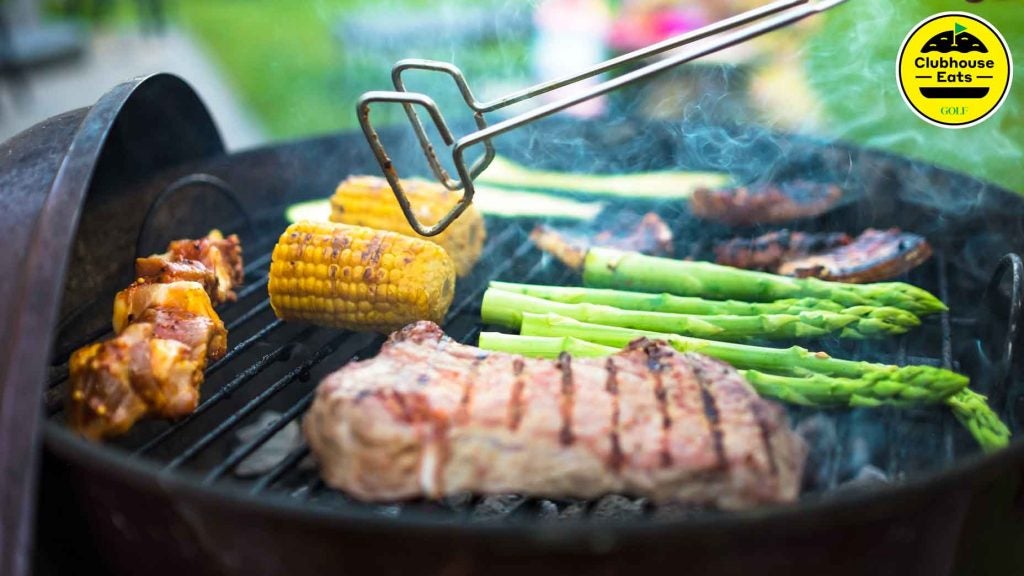Welcome to Clubhouse Eats, where we celebrate the game’s most delectable food and drink. Hope you brought your appetites.
***
It’s an age-old story: boy meets grill. For Brian Coseo, the love affair began when he was a teenager in Vermont, helping his dad with backyard cookouts. And it burns on today in his role as executive chef at Sea Pines Country Club, in Hilton Head, South Carolina, where grilling is a staple of his repertoire.
With summer underway and the Fourth of July just around the corner, we asked Coseo for an overview of grilling fundamentals. Here are seven of his hottest takes.
1. Fire it up
As with golf, a proper warmup is essential. A lot of home cooks overlook that step. “They’ll throw stuff on the grill before it’s hot enough,” Coseo says. The right way to go, he says, is to pre-heat your grill to a temperature of 450 to 500 degrees before you start cooking. Getting things nice and hot not only makes it easier to scrape grates clean, it also prevents items from sticking to the grill.
2. No thermometer? Do a hand check
Many grills have built-in temperature gauges. If yours doesn’t, Coseo suggests using an oven thermometer (you can buy a good one for as little as $10). In a pinch, you can also use the hand-check method by holding your hand a few inches over the grill and counting Mississippis. If you can stand the heat for 2 to 4 Mississippis, the temperature is likely in the 400 range. If you have to pull away after a 1 or 2 count, the grill is probably up to 450 to 500 degrees.
3. Gas or coals?
Both have benefits. While gas is often more convenient and makes it easier to control temperatures, coals impart appealing smokey flavor, all the more so if you add wood chips to the mix. Though Coseo has a gas grill at home for ease of use, he’s generally agnostic about the choice. His only hard-set rule is to stay away entirely from lighter fluid, which he says gives food a “chemical flavor.” He recommends using a charcoal chimney.
4. Keep it covered
Whenever possible, keep the grill covered. It helps maintain desired temperatures, prevents flareups and limits the chances of the grilled items drying out.
5. Different meat, different heat
Unlike barbecuing, which happens low and slow, grilling involves cooking at high heat, but not all of that heat is created equal. When you’re grilling smaller, individual items that cook relatively quickly, such as a burger, a chicken breast or a tuna steak, you want that heat to be direct, with the item placed immediately above the fire. For larger items, though, like, say, a honking cut of beef or a whole chicken, direct heat is apt to scorch the outside of the protein before the insides are entirely cooked through. Indirect heat is the better way to go. If you’re using coals, Coseo says, separate them into two piles on the side, and set the large cut of protein over the cooler spot in the middle. If you’re using gas, the same rule applies; keep the side burners blazing but the center ones turned low or off. As a general rule, Coseo says, anything that takes longer than 20 minutes to cook is better off grilled over indirect heat.
6. Don’t flip out
Or, better yet, try not to flip whatever you’re cooking more than once. That will help ensure a nice caramelized sear on both sides.
7. And for the veggies …
Onions. Potatoes. Eggplant. Squash. When it comes to grilling veggies, Coseo recommends brushing them with olive oil first. But not too much. Just a light coat. Go too heavy, and the excess oil will drip down and spark flareups (the same is true of marinated meat proteins; you want them to be seasoned, not soaked). Some vegetables involve more effort than others. Take corn on the cob, a summer grilling favorite. Coseo’s preferred method goes like this: he shucks the corn, removes the silk, brushes the kernels with oil or butter, seasons them with salt and pepper, then wraps them back in the husks before putting them on the grill. “It’s a bit of extra effort,” Coseo says. “But it pays off in the results.”
